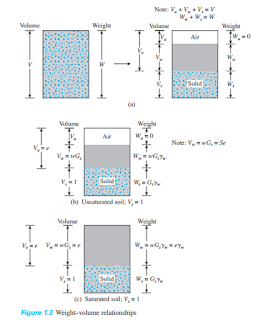Several organizations have attempted to develop the size limits for gravel, sand, silt, and clay on the basis of the grain sizes present in soils. Table 1.2 presents the size limits recommended by the American Association of State Highway and Transportation Officials (AASHTO) and the Unified Soil Classification systems (Corps of Engineers, Department of the Army, and Bureau of Reclamation). The table shows that soil particles smaller than 0.002 mm have been classified as clay. However, clays by nature are cohesive and can be rolled into a thread when moist. This property is caused by the presence of clay minerals such as kaolinite, illite, and montmorillonite. In contrast, some minerals, such as quartz and feldspar, may be present in a soil in particle sizes as small as clay minerals, but these particles will not have the cohesive property of clay minerals. Hence, they are called claysize particles, not clay particles.
WEIGHT VOLUME RELATIONSHIP:
In nature, soils are three-phase systems consisting of solid soil particles, water, and air (or gas). To develop the weight–volume relationships for a soil, the three phases can be separated as shown in Figure 1.3a. Based on this separation, the volume relationships can then be defined. The void ratio, e, is the ratio of the volume of voids to the volume of soil solids in a given soil mass, or
e = Vv/Vs
The degree of saturation, S, is the ratio of the volume of water in the void spaces to
the volume of voids, generally expressed as a percentage, or
Note that, for saturated soils, the degree of saturation is 100%.
The weight relationships are moisture content, moist unit weight, dry unit weight,
and saturated unit weight, often defined as follows:
More useful relations can now be developed by considering a representative soil specimen
in which the volume of soil solids is equal to unity, as shown in Figure 1.3b. Note that
if then, from Eq. (1.4), and the weight of the soil solids is
The saturated unit weight of soil then becomes
In SI units, Newton or kiloNewton is weight and is a derived unit, and g or kg is
mass. The relationships given in Eqs. (1.11), (1.12) and (1.16) can be expressed as moist,
dry, and saturated densities as follow:
Relationships similar to Eqs. (1.11), (1.12), and (1.16) in terms of porosity can also
be obtained by considering a representative soil specimen with a unit volume (Figure 1.3c).
These relationships are
Except for peat and highly organic soils, the general range of the values of specific
gravity of soil solids found in nature is rather small. Table 1.4 gives some representative
values. For practical purposes, a reasonable value can be assumed in lieu of running
a test.













No comments:
Post a Comment